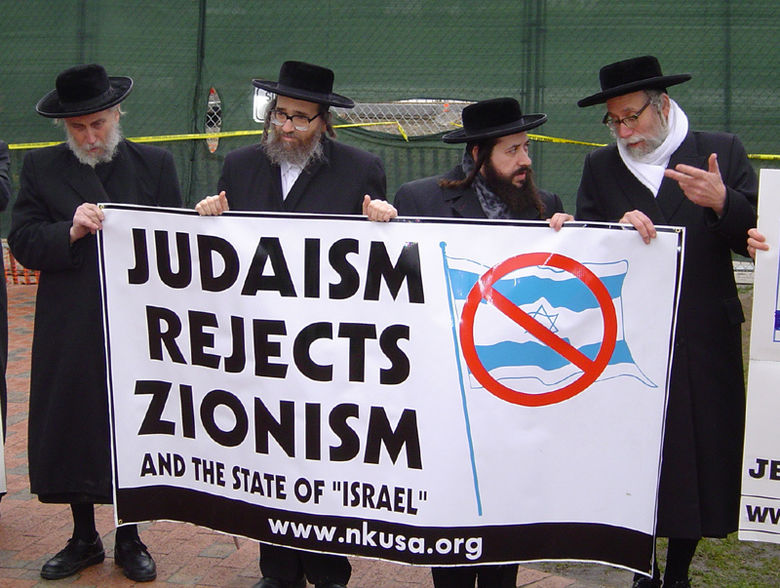
Zionism succeeded as a mission and failed as a concept. Starting with false premises, Zionism fulfilled promises to its followers, enabled some Jews to obtain a better life, and added little to what the established Jewish community had already achieved and was continuing to achieve. It traded destruction, oppression, and decades of suffering of the Palestinian community for a contrived state, a supposed ideal nation where all Jews would easily integrate and be safe from persecution and physical danger. As will be shown, Jewish immigrants to Israel struggled with integration, encountered persecution, and subjected themselves to physical danger that can be unending and cataclysmic to the Israeli population.
The False Premises of Zionism
Political Zionism constructed its ideology at the end of the 19th century on several premises, (1) Extensive persecution of Jews would continue and drive the Jews need for a homeland of their own, and (2) Jews could never satisfactorily integrate into western nations.
Persecution of Jews in Western Europe
Leave aside attacks on Jewish life in North Africa, especially Algeria, and parts of the Middle East, which Zionism never seemed to consider, and postpone examination of happenings in the Pale of Russia during the 19th century. Regarding the fate of Western European Jews during the same century, which captures the time and events by which the Zionists framed their ideology, available data does not support extensive persecution of Jews in the immediate decades before Theodore Herzl framed his doctrines. Although government sponsored improvements provoked civil resistance to them, Jews obtained legal equality in all major European nations, and decades before Theodore Herzl proclaimed his Zionist manifesto. The road to emancipation contained a number of anti-Jewish riots, a few forced and voluntary expulsions, personal anti-Jewish behavior, and some incitement against Jews, but those temporary incidents involved a small part of European Jewry population and locations, and rarely erupted into severe bodily harm or killings.
Pursue any timeline on 19th century anti-Semitism, such as at https://en.wikipedia.org/wiki/Timeline_of_antisemitism_in_the_19th_century, and the record shows that physical attacks on western European Jews, after a brief episode of the 1819-1826 Hep-Hep riots in Germany, were few. Not few were verbal attacks that coalesced into a group called the League of anti-Semites, who believed, “They (Jews) placed the Jewish state higher than all others,” and that “Judaism functioned as a form of theocracy, in which religious faith is identical with a Jewish state constitution and system of law enforcement. The full emancipation of Jews therefore presupposed their emancipation from Judaism.”
Quick to signal the anti-Semites as a major peril to the Jewish community, the Zionists used the danger to emphasize the necessity for its own mission, conveniently disregarding that their message resembled, in a convoluted manner, that of the anti-Semites — emancipation meant Jews would shed their Judaism, and, therefore, their salvation depended upon leaving Europe and establishing their own state. The anti-Semites directly promoted Zionism’s thrust and, in effect, the doctrines of the anti-Semites coincided, albeit not for the same reasons, with much of the Zionist’s objectives.
An honest Zionism would have clarified that the anti-Semites’ charges were completely rejected by their peers and the European governments.
Wilhelm Marr, a revolutionary and extreme leftist of the German Radical-Democratic Party, and considered the most prominent member of the later formed League of anti-Semites, published his initial anti-Jewish work Der Judenspiegel ( The Jews’ Mirror ) during June,1862. Werner Bergmann, Professor at the Center for Anti-Semitism Research at the Technical University of Berlin, in an article, Wilhelm Marr’s A Mirror to the Jews, Key Documents of German-Jewish History, September 22, 2016, describes the effects of Marr’s words.
His democratic party colleagues distanced themselves from him. He lost his seat in a new election for the Hamburg city council, forcing him out of politics and limiting his activity to journalism and political commentary. Moreover, the appearance of “Der Judenspiegel” evoked no great resonance and was not taken all that seriously, but rather as some sort of “farce.”
The Zionists mischaracterized the life of western European Jews to suit their agenda. Religiously motivated actions that caused wide damage and promoted violence to Western Europe Jews during the Middle Ages had subsided, replaced by local expressions that accused Jewish people of economic competition in an era of rapid industrial development, which introduced innovative forms of finance and production in a new system — capitalism. The verbal abuse stung Jewish psyche but had little effect on the course of Jewish life in the 19th century. Zionists also exaggerated attacks on their fellow Jews in the Russian Empire.
Persecution of Jews in the Russian Pale
The lack of sufficient communications in Russia during the 19th century, coupled with a tendency to create sensational news and accept exaggerated rumors, has made it difficult to ascertain the nature and extent of attacks on Russia’s Jewish community. The YIVO Encyclopedia of Jews in Eastern Europe, an English-language reference work on the history and culture of Eastern Europe Jewry, prepared by the YIVO Institute for Jewish Research and published by Yale University Press in 2008, seems a more objective and authoritative source. Excerpts from their work, which can be found at https://yivoencyclopedia.org/article.aspx/Pogroms, are quoted.
Anti-Jewish violence in the Russian Empire before 1881 was a rare event, confined largely to the rapidly expanding Black Sea entrepot of Odessa. In Odessa, Greeks and Jews, two rival ethnic and economic communities, lived side by side. The first Odessa pogrom, in 1821, was linked to the outbreak of the Greek War for Independence, during which the Jews were accused of sympathizing with the Ottoman authorities. Although the pogrom of 1871 was occasioned in part by a rumor that Jews had vandalized the Greek community’s church, many non-Greeks participated, as they had done during earlier disorders in 1859.
The pogroms of 1881 and 1882, which occurred in waves throughout the southwestern provinces of the Russian Empire, were the first to assume the nature of a mass movement. Typically, the pogroms of this period originated in large cities, and then spread to surrounding villages, traveling along means of communication such as rivers and railroads. Violence was largely directed against the property of Jews rather than their persons. In the course of more than 250 individual events, millions of rubles worth of Jewish property was destroyed. The total number of fatalities is disputed but may have been as few as 50, half of them pogromshchiki who were killed when troops opened fire on rioting mobs.
Granted, the Russian Pale restricted and punished Jewish life. Tsar Alexander gained power in 1855 and lessened anti-Jewish edicts in the Russian Empire, rescinded forced conscription, allowed Jews to attend universities, and permitted Jewish emigration from the Pale. His assassination in 1881, blamed on “foreign influence agents,” a reference that included Jews, prompted Tsar Alexander III to reverse his father’s actions and instigated the 1881-82 pogroms on Jews.
Violation of any human life can neither be underestimated nor ignored; Jews suffered in the 19th century Russian Empire, and so did almost everyone else. Placed in context — location, time, comparison of the fate and life of Jews to other minorities, and internal and external factors that favored the Jews — and the reasons for Zionists to behave as the rescuer of their co-religionists become questionable.
For others, also not of the Russian Orthodox faith, persecution was magnitudes worse.
From http://www.balfourproject.org/the-jewish-question-in-19th-century-europe/
The Moscow Patriarchate presided over the state religion and other believers were generally disadvantaged, often persecuted, or sometimes driven from Russian lands. The non-Orthodox were despised as unbelievers and thousands of Catholics were deported to Siberia in the mid-19th century. At the same time, around half a million Muslims were driven from the Caucasus to the Ottoman Empire, Iran or further afield. At the south-eastern border of the Pale of Settlement began the lands of the Circassians, a mostly Muslim group who had lived since the 14th century along the northern Black Sea coast from Sochi and eastwards into the Caucasus mountains. A long war of attrition ended in the genocide of 1865. According to official Russian statistics, the population was reduced by 97 per cent. At least 200,000, and possibly several hundred thousand people died through ethnic cleansing, hunger, epidemics and bitterly cold weather.
Despite problems, many Jews managed to survive well.
From Yivo Institute for Jewish Research at https://yivoencyclopedia.org/article.aspx/Odessa
…Jews represented the fastest-growing commercial group in the city (Odessa). Greeks and Italians owned the bulk of the real estate and, until mid-century, dominated the grain trade. By 1851, however, of the 5,466 individuals engaged in trade, 2,907 (53.2%) were Jews (by then, 17,000 Jews lived in the city). Following the Crimean War and its disruptive impact on Black Sea trade, Jews achieved primacy in grain export; by 1875, more than 60 percent of the city’s commercial firms were in Jewish hands. By the early twentieth century, 89 percent of the grain export from Odessa was controlled by Jewish-owned firms, with Jews owning half of the city’s factories and 888 of its 1,410 smaller workshops.
Russian Jews could organize.
From http://www.balfourproject.org/the-jewish-question-in-19th-century-europe/
Foremost among many revolutionary groups, however, was the Algemeyner Yidisher Arbeter Bund in Litah, Poyln un Rusland, known in the West as the Bund. Founded in Vilnius in 1897 by delegates representing some 3,500 members, the Bund played a central role in creating the Russian Social Democratic Labour Party (RSDLP), with three of the nine delegates at the founding session. Their practical engagement for and wide support among working people contrasted starkly with the well-heeled elite who gathered around Theodor Herzl in Vienna whose Zionist movement was launched in the same year. But the Bund insisted on Jewish nationality in a socialist system within a Russian federation of nationalities.
Not all Russian Jews accepted Zionism.
Unwaveringly secularist in its beliefs, the Bund also relinquished the idea of the Holy Land and the sacred tongue. Its language was Yiddish, spoken by millions of Jews throughout the Pale. This was also the source of the organization’s four principles: socialism, secularism, Yiddish and doyikayt or localness. The latter concept was encapsulated in the Bund slogan: “There, where we live, that is our country.”
The Bund disapproved greatly of Zionism and considered the idea of emigrating to Palestine to be political escapism.
Jews had an escape route
Mass emigration was solving their problems in Russia. From 1881 to 1914, more than 2.5 million Jews migrated from Eastern Europe. Of these, about two million reached the United States, 300,000 went to other overseas countries, and approximately 350,000 chose Western Europe.
At the end of the 19th century, life was not perfect for European Jews, but they had made tremendous economic, social, and political gains, and the trend continued positive. Compared to other ethnicities, such as Southern Italians, Irish, Native Americans, African-Americans, Chinese-Americans, and religions, especially American Catholics, prejudice and discrimination that limited their lives was negligible. Jews ignored the Zionist desperate attempts to rescue them from, from, from what, and the Zionists sought other reasons for their mission.
Jews could never satisfactorily integrate into western nations
With Jews becoming well represented in educational institutions and government positions, becoming well known in all cultural representations — music, art, theatre, and writing — and managing to become successful wage earners in many avenues of employment, the Zionist case that “Jews could never satisfactorily integrate into western nations” became more dubious with each passing day. Surely, there must be examples of European intent to keep Jews from obtaining equal status. According to Zionist followers, Theodore Herzl found that case in the treacherous campaign against the person of Captain Alfred Dreyfus., the final blow that made him decide Zionism was the only way for the Jews,
The Dreyfus case, in which a Jewish military officer in the 1896 French army was sentenced for giving military secrets to the Germans, has been documented in books, articles, and a movie, not for a few years in France but continuously and non-ending in the United States, whose population has no relation to the French incident. Highlighted, as an example of severe anti-Semitism in the French military, extended to the French populace, the Dreyfus case constantly circulates in the media, gives the Dreyfus case a life of its own, and makes it seem that there is not one Dreyfus but thousands, and the spectra of their adversaries lurk in every military establishment. Why this occurs is easily answered — the Zionists needed a Dreyfus to substantiate their mission for all time. Actually, the Dreyfus case contradicted the Zionist mission; being an isolated case, it proved Jews could integrate into European institutions and receive equal justice.
Was the French military, at that time, rife with anti-Semitism? According to Piers Paul, The Dreyfus Affair. p. 83, “The French army of the period was relatively open to entry and advancement by talent, with an estimated 300 Jewish officers, of whom ten were generals.” (Only five African-American officers in the much larger US army in WWII.) Why would an institution “rife with anti-Semitism” permit a recently emancipated and relatively small minority to advance so rapidly?
Did not justice give Dreyfus his freedom in a short period of time? He was more fortunate than the many soldiers of military injustices were, where a scapegoat for incompetence is needed, and someone who has no close benefactor for support receives the penalty. The literature entertains myriads of similar cases; as examples, go to https://listverse.com/2013/07/13/ten-examples-of-deplorable-military-injustice/.
Why do the media presentations of the Dreyfus case stress injustice? Because the French military gave Dreyfus and 300 other Jews at that time the opportunities to advance to officer rank, and because Captain Dreyfus eventually became rehabilitated, why not stress that French Jews received equality and eventual justice? The more lingering question — why is the Dreyfus case, which has nothing to do with Americans, popular in America? Why are not Americans interested in the African American Dreyfuses, of which there are many, but not mentioned in movies, articles and books? Who has heard of
John H. Conyers, an African-American who resigned after his first year at the US Naval Academy (1872-1873 ), due to severe, ongoing hazing, including verbal torment, shunning, and beatings, and even an attempt to drown him, and
Private Charles Lewis, another African-American, arrested for attempted robbery while wearing his uniform, one month after World War I ended. While awaiting transfer to the county jail, masked men entered his jail, pulled him out of his cell, tied a rope around his neck, and hanged him from a tree?
Lots more, but the point is clear.
In summary, based on the injustice done to one Jewish officer, one of several hundred Jewish officers worldwide, Theodore Herzl concluded that Jews around the world should uproot themselves from their native countries, leave their jobs, and voyage to a barren region where they would not be welcome, live a life of desperation, and be victims of attacks, all of which turned out to be true.
The 19th century emancipation movements liberated Western European Jews and permitted them to integrate into European society. Jews rejected the Zionist agenda, which they perceived as prompting nations to question their loyalty, served to impede their advances, and reinforced a race-baiting theory that Jews engaged in international conspiracies. Anti-Zionist Rabbis insisted: “Zion exists everywhere but in Zion.”
Nevertheless, Zionism pushed forward and eventually succeeded in establishing a state for Jews. Was it entirely political skill or fortuitous circumstances?
How Zionism Succeeded in its Mission
Note: Jewish population statistics in Palestine are taken from the Jewish Virtual Library at https://www.jewishvirtuallibrary.org/jewish-and-non-jewish-population-of-israel-palestine-1517-present
From its beginnings to start of World War I, Zionism proved a stagnant adventure. During that period, about 80,000 Jews came to Palestine, not all of whom were Zionists, many being adventurists, utopian Socialists, and some seeking opportunities. By 1918, only about 60,000 remained. Meanwhile, more than 2,500,000 Jews ventured to other places, mostly to the United States. World War I, destruction of the Ottoman Empire, and the Balfour Declaration revived the Zionist adventure. In addition, the League of Nations’ certification of the British Mandate in Palestine prevented the formation of a national Palestinian governing body, and provided opportunities for English speaking European Jews to work in the British administration
Suddenly, the Ottoman Empire was no longer an impediment for Jews to enter Palestine. They came with the blessings of a Balfour Declaration that certified their validity, and with protection of his Majesty’s forces. From 1918-1922, approximately 24,000 Jews arrived in Palestine.
The year 1924 was more fortuitous for the Zionists. The US Immigration Act closed the doors to mass Jewish immigration from East European nations and this Act steered Jews to Palestine. By 1931, Palestine housed 175,000 Jews. Did they arrive as Zionists or as others who seek an improved economic situation from their depressed surroundings?
In the 1930’s, and until the end of World War II, Nazi persecutions of the Jews drove more than 60,000 German Jews to immigrate to Palestine (about 280.000 German and Austrian Jews migrated to other places, with about 125,000 managing to come to the to the United States). The Ha’avara Transfer Agreement enabled the Zionists to receive commercial assistance from the trade of Jewish assets, including bank deposits, for purchase of German products that were exported to the Jewish-owned Ha’avara Company in Tel-Aviv. Money from the sales of the goods went to the emigrants upon their arrival in Palestine in an amount corresponding to their deposits in German banks. .
A barter agreement by which the Zionists in Palestine exchanged oranges and agricultural products for German timber, automobiles, agricultural machinery, and other goods supplemented the Ha’avara. For a time, the Ha’avara Agreement helped the Nazis to undermine the anti-Nazi boycott initiated by the American Jewish Congress.
Revelations of the Holocaust and plight of Jewish refugees after World War II gained worldwide sympathy for the Zionist cause and propelled more immigrants to Palestine. The Cold War provided the most decisive benefit for Zionism — the Soviet Union support for an Israeli state drove the United States to compete for Zionist attention and votes from both nations provided a narrow one vote victory (needed 2/3) for United Nations Declaration 181 and established the Zionist state.
The rest is history — battles between Israel and its adversaries, which Israel always won and from which it was able to expand its initial territory and dominate the original inhabitants of the Levant. Israel’s population grew from those seeking shelter from economic deprivation and from despotic regimes, and not necessarily from people who were Zionists. After the 1967 War, a new class of Zionists emerged — those who wanted to share in Israel’s victories and had their own spurious reasons for Zionism — Jews needed a homeland to secure themselves from another Holocaust, and they were returning to their ancestral lands and retrieving a glorious past. The more religious supported the thesis that this was a land promised to them by God.
Lessons from the Holocaust
The deceased from the terrible Holocaust tragedy have not been permitted to rest; they have served a multiple of agendas — a money making industry of books, films and plays, reparations for victimization, special advantages for sympathy, and for the post 1967 Zionists, a means to rationalize their oppression of the Palestinian people. For the new Zionists, the world is a sewer of ant-Semitism waiting to commit another Holocaust on the Jewish people and only a strong and united Israel can escape the catastrophe — a prophecy they seem only too eager to make happen.
The Zionists sought in the Holocaust a way to satisfy its agenda. They eschewed a major lesson from the tragic event, Jews must not assemble in one place, and their survival depends upon tribal scattering. The Holocaust localized to parts of Europe, and the worldwide dispersal of the Jews enabled their survival as an ethnicity. This attribute is a general thesis of species survival — the more diversified is a species, the better chance it has of survival.
Statistics on casualties to Israeli Jews (https://www.jewishvirtuallibrary.org/total-casualties-arab-israeli-conflict), compared to 19th European Jews at the time of the Zionists, demonstrate that the gathering of the Jews has not made them more secure or safe.
As shown previously, less than 100 Jews were killed, and possibly a few thousand injured in anti-Jewish riots during the 19th century years that preceded the establishment of political Zionism. From the start of the British mandate in 1919 until the year 2019, 71 years after the founding of Israel, 24,060 Jews have been killed and 36,260 have been wounded in the Levant. Due to identification of the Jews with Israel, attacks on Jews in the western world are increasing. Sheltered by high walls and a strong military, Israeli Jews have been able to defend themselves against embittered enemies. If ballistic missiles make the walls superfluous and Israel’s adversaries become militarily strong, the Zionist mission will turn into a modern Sicarii, repeating those who claim to speak for the Jewish people and bringing them to eventual decline.
Safety from Persecution
The literature is saturated with prejudices by Israel authorities against the Middle East and North African Jews, Yemenite Jews, and Ethiopian Jews (Falasha), and the difficulties these groups experienced to integrate in Israeli society.
From the BBC in 2015 at http://www.bbc.com/news/world-middle-east-32813056.
Many of the Ethiopian Israelis live in the periphery of society that already grapples with issues of unemployment and scarce public resources, makes it more difficult for them to integrate, and causes friction with the more veteran population.”
In the year 2013, 60 years after the Middle East and North African Jews came to Israel, government studies conducted in conjunction with The Hebrew University of Jerusalem found that “a job applicant with an Ashkenazi-sounding name has a 34 percent higher chance of being hired by an employer than a person with a Sephardi-sounding name applying for the same position, [and also that] over 22% of employers openly stated that they actively discriminate against applicants with Arab-sounding names.” (https://employmentdiscrimination.foxrothschild.com/2013/08/articles/employee-hiring/discrimination-in-israel-against-applicants-with-sephardi-or-arab-sounding-names/)
The Middle East and North African Jews who came to Israel were Arabs; the Ashkenazi were European; the Falasha were Ethiopians; and the Yemenites were from the Arabian Peninsula. Israel replaced the differing languages, dialects, music, cultures, and heritage of these ethnicities with unique and uniform characteristics, and created a new people, the Israeli Jews. Destruction of centuries old Jewish history and life in Tunisia, Iraq, Libya, and Egypt accompanied the creation of a new people. The Zionists, who complained about persecution of Jews, wiped out Jewish history, determined who was Jewish, and required all Jews to shed much of their ancestral characteristics before they could integrate into the Israel community. Their actions showed that the dominant authority rarely allows others to compromise its dominance, and they were no different, and certainly not better, than others they accused of preventing advancement of Jewish communities.
Returning to their ancestral lands and retrieving a glorious past
The leading argument of the post-1967 Zionists has the Jews returning to their ancestral lands and retrieving their glorious past. For someone in a 21st century A.D. land to tie him/her self to others in a faraway, 10th century B.C. land is ludicrous. Maybe, Native American tribes should claim Siberia and return to their ancestral lands.
Historical evidence shows that after the ancient Hebrews, due to conquest and subjugation, faded from history, many of the later Jews were not attached to the land and did not consider it a national home — just the opposite — a large number of the later Jews preferred to remain in Babylonia and move throughout the Roman Empire, populating Alexandria, Rome, Cyrenaica, Salonika, Cyprus, and other places. Freed from a pastoral life, dry conditions, and restricted economies, new communities of Mesopotamian Jews, knowledgeable and worldly, appeared in the Fertile Crescent. That region, which housed the great Jewish academies of Surah, Pumbadita, and Nehardea, best expressed the legacy and heritage of modern Judaism. In The Chosen Few: How Education Shaped Jewish History, 70-1492, winner of the 2012 National Jewish Book Award in Scholarship, by Maristella Botticini, Zvi Eckstein, Princeton University press, 2012, the authors claim that “Judaism reached its Golden Age in 800 -1200 A.D. During that time, Mesopotamia and Persia contained 75% of world Jewry with the rest in North Africa and Western Europe.”
A constant drumming of public relations and historical misconceptions have made it seem as if the more than two thousand years of lack of control and physical presence by Jews in the Levant did not occur. Today is portrayed as only a short interval from the 2700-year-old reign of ancient King Hezekiah. Centuries of Christian and Crusader rule and more than one thousand years of Muslim rule and their tremendous constructions and creations in Jerusalem are downplayed. The Christian and Muslim everything become nothing, and a minor Hebrew something becomes everything. Myth replaces reality. Ethereal spirituality replaces physical presence.
The Holy Basin contains well-marked Christian and Muslim institutions and holy places that have had historical placement for more than a millennium — Church of the Holy Sepulcher, Al Aqsa Mosque, Dome of the Rock and its Mosque of Omar. Some remains of Jewish dwellings, burial grounds and ritual baths can be found, but few, if any, major Jewish monuments, buildings or institutions from the Biblical era exist within the “Old City” of today’s Jerusalem. The oft-cited Western Wall is the supporting wall for Herod’s platform and is not directly related to the Second Temple. According to historian Karen Armstrong, in her book Jerusalem, Ballantine Books, April 29, 1997, Jews did not pray at the Western Wall until the Mamelukes in the 15th century allowed them to move their congregations from a dangerous Mount of Olives and pray daily at the Wall. At that time, she estimates that there may have been no more than 70 Jewish families in Jerusalem. Have 70 Jewish families determined the “holiest site” of the Jews? No remains of the Temple have been located.
Myths have been portrayed as reality and that portrayal is incorrect.
The Failure of Zionism
Previous arguments indicate that early and later Zionists erred in their original premises and concepts. One principal revelation is that the Jews did not show a strong attachment to an ancestral land, and traveled widely in search of economic opportunities. By myopic vision, and use of worldwide public relations Zionism proves to itself and others that it has been a success, and does this by setting the definitions of who is Jewish, what is a Jewish state, what is persecution, and what is success. Conveniently ignoring the violent and oppressive means it took to assure its “success,” they obfuscate the obvious — because the Jews, unlike Catholics, Mormons and other religions, do not have a hierarchy of authority, and any centralized command and control, Israel cannot be a Jewish state. Having no defined borders, can Israel even be called a state? Is it better defined as an entity in which a privileged nationality, Jews, as defined by Israel laws, dominate and rule a land over all the other nationalities that are its citizens?
Does Israel have an Israeli nationality? The answer is vague, but not vague is that Israel has an abundance of listed nationalities of whom the two most prominent are Jewish and Arab. The Jews from the Middle East and North Africa were actually both — Jewish and Arab. Most of them identified with the Palestinian Arabs — spoke the same language, shared the same music, ate the same foods, and dressed similarly. Many were alienated from the Europeans with whom they could not relate. So, why were they given a Jewish nationality and not an Arab nationality? True, they had left Arab nations, but had they left their ancient Arab heritage, which had been part of them for centuries?
This is polemics, but it shows the confusing methods that the Zionists used to define everything in their favor, including using security and defense measures as shields for ethnic cleansing and oppression.
To certify themselves to others, the Zionist bind themselves with the Jewish populations and impress the public. The keynote speaker at a special ceremony for Jewish graduates at UCLA, Dr. Judea Pearl, argued, “anti-Zionism was correctly seen as an attack on Jews because Zionism is an essential component of Jewish identity;” the mark of Zorro, the big “Z” is slashed into the minds of all Jewish persons. If Zionism is an essential component of Jewish identity, why does the Jewish Virtual Library at https://www.jewishvirtuallibrary.org/first-zionist-congress-and-basel-program-1897 state there were only 200 attendees (69 delegates) at the first Zionist convention? Where were the other millions?
It is surprising that Jews do not have lawsuits against people, such as Pearl (and against the Israeli government), for insulting them and opening them for attack by libelously associating them with a virulent nationalist, militarist and scheming ideology that has led to the destruction of masses of peoples, and for little reasons.
Why little reasons? The orthodox and ultra-orthodox Jews could have stayed and prayed at their original synagogues in Brooklyn, Los Angeles, London, and elsewhere without concern of being conscripted into the military. They have not seen any difference in their lives. The Ashkenazi were doing well in their western lands and would, as their brethren, continue to do well. The Russkies could have participated in a new Russia, or even, as many have done, gone to a new Germany. After the German government recognized Jews from the former Soviet Union as refugees, and granted them residence, work permits and social rights, 250,000 Russian Jews of all types immigrated to Germany (includes people related to Jews who do not follow Jewish laws).
The Middle East and North African Jews, and Falasha lived for more than a thousand years in their respective areas, found places in their native cultures, many in the middle class, and, as all minority peoples, had their ups and downs. They were prepared to extend the freedoms that began on November 3, 1839, when the Ottoman Gulhane Decree (Hatt-i Sharif) promised to “Protect the lives and properties of its subjects; Insert a new code of Justice asserting equal status of Muslims, Jews and Christians before the law; Institute a regular system of levying taxes; Develop a fair method of conscripting subjects for service in a modernised army and navy.” Designed to improve the status of the non-Muslim population, the reforms granted them equal status before the law with Muslims. The subsequent new Ottoman Constitution, December 13, 1876, made all subjects Ottomans by law. By doing so, everyone, regardless of their religion, had the right to liberties, such as freedom of press and free education.
Nevertheless, the Constitution and reforms had various local oppositions and the Jewish and Christian communities, from time to time, received attacks.
The principal result of the original Zionist agenda is easily observed — Zionism helped some Jews escape poverty and oppression, negatively shadowed the lives of others, and encouraged many to uproot themselves for spurious reasons and negligible benefits. All this gained by the theft of Palestinian lands, dislocation of millions of Palestinians, destruction of the Palestinian community and potential genocide of the Palestinian people. Every night is Kristallnacht in the West Bank and Gaza. In fairness to Theodore Herzl and his fellow Zionists, they may have had good intentions and their original agenda may not have included oppression of others. However, because the Zionist movement had no legs from the start, it was bound to become a perverted Messianic movement, which, like communism, had to oppress others to preserve itself.
Zionism succeeded as a mission and failed as a concept, a failure that might eventually spell doom for the entire Jewish community. Can there be any hope for Zionism in its present path — what else can there be but continuous conflagrations and excessive casualties? Better to reverse course, retreat to success, and repair the damage it has done to others — a win-win proposition that excites the imagination and will make the Middle East livable and loveable for Jews and Arabs.
Dan Lieberman edits Alternative Insight, a commentary on foreign policy, economics, and politics. He is author of the book A Third Party Can Succeed in America, a Kindle: The Artistry of a Dog, and a novel: The Victory (under a pen name). Dan can be reached at [email protected]
SIGN UP FOR COUNTERCURRENTS DAILY NEWS LETTER









































